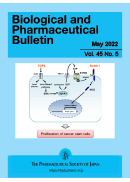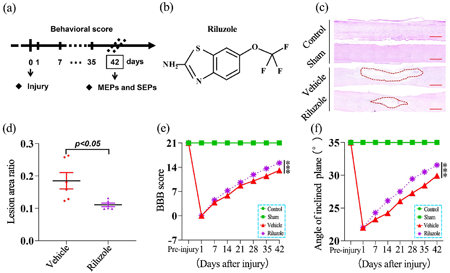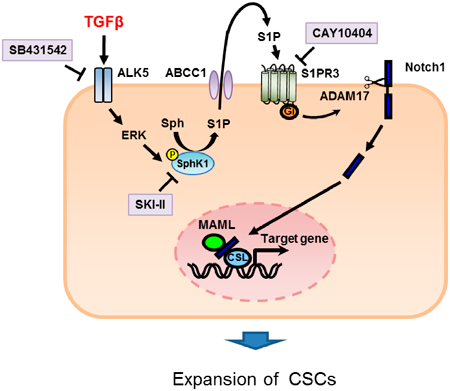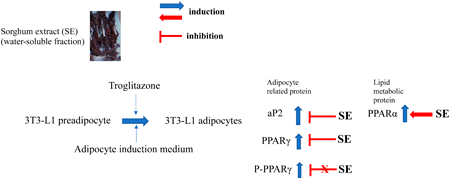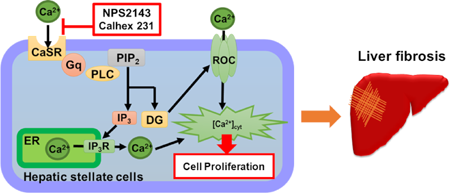- |<
- <
- 1
- >
- >|
-
2022 年 45 巻 5 号 p. 553-560
発行日: 2022/05/01
公開日: 2022/05/01
[早期公開] 公開日: 2022/03/18PDF形式でダウンロード (8276K) HTML形式で全画面表示 -
2022 年 45 巻 5 号 p. 561-568
発行日: 2022/05/01
公開日: 2022/05/01
[早期公開] 公開日: 2022/02/19PDF形式でダウンロード (7805K) HTML形式で全画面表示 -
2022 年 45 巻 5 号 p. 569-575
発行日: 2022/05/01
公開日: 2022/05/01
PDF形式でダウンロード (5020K) HTML形式で全画面表示 -
 2022 年 45 巻 5 号 p. 576-582
2022 年 45 巻 5 号 p. 576-582
発行日: 2022/05/01
公開日: 2022/05/01
Editor's pickSacran, a type of new sulfated polysaccharide, is a biomaterial with excellent water solubility and safety, and is expected to be used in pharmaceuticals of the future. In the present study, sacran suppressed oxidative stress and inhibited the progression of chronic kidney disease (CKD). Sacran also had a multifaceted effect on the progression of CKD by altering the mix of intestinal microflora as a prebiotic in addition to the above effects. Thus, sacran is expected to have an effective nephroprotective effect especially when oxidative stress initially appears at the early stage of renal failure.
PDF形式でダウンロード (4950K) HTML形式で全画面表示 -
2022 年 45 巻 5 号 p. 583-589
発行日: 2022/05/01
公開日: 2022/05/01
PDF形式でダウンロード (767K) HTML形式で全画面表示 -
2022 年 45 巻 5 号 p. 590-595
発行日: 2022/05/01
公開日: 2022/05/01
PDF形式でダウンロード (453K) HTML形式で全画面表示 -
2022 年 45 巻 5 号 p. 596-604
発行日: 2022/05/01
公開日: 2022/05/01
PDF形式でダウンロード (2764K) HTML形式で全画面表示 -
2022 年 45 巻 5 号 p. 605-613
発行日: 2022/05/01
公開日: 2022/05/01
[早期公開] 公開日: 2022/03/15PDF形式でダウンロード (3163K) HTML形式で全画面表示 -
 2022 年 45 巻 5 号 p. 614-624
2022 年 45 巻 5 号 p. 614-624
発行日: 2022/05/01
公開日: 2022/05/01
Editor's pickHepatocellular carcinoma is one of the most frequent cancers. Sinomenine (SIN) is a compound derived from Sinomenium acutum. Authors’ investigations have found that SIN suppressed SK-Hep-1 cells’ proliferation, enhanced the collapse of potential of the mitochondrial membrane, triggered cell apoptosis, down-regulated PI3K p85α, AKT1, BCL-2, Pro-Caspase 9, Pro-Caspase 3 expressions, and up-regulated Cleaved Caspase 9 and Cleaved Caspase 3 expressions. In addition, insulin-like growth factor-1 could reverse the high apoptosis of SK-Hep-1 cells induced by SIN. Therefore, authors revealed that inhibition of PI3K/AKT1 signaling cascade by SIN induced hepatocellular carcinoma cells apoptosis.
PDF形式でダウンロード (11712K) HTML形式で全画面表示 -
2022 年 45 巻 5 号 p. 625-634
発行日: 2022/05/01
公開日: 2022/05/01
PDF形式でダウンロード (5390K) HTML形式で全画面表示 -
 2022 年 45 巻 5 号 p. 635-642
2022 年 45 巻 5 号 p. 635-642
発行日: 2022/05/01
公開日: 2022/05/01
Editor's pickAtrial enlargement often provides arrhythmogenic substrates, leading to the induction of atrial fibrillation. The authors examined the anatomical, molecular biological, and electrophysiological characteristics of remodeled atria in rats with 8- and 12-week of aorto-venocaval shunt (AVS). It is noteworthy that marked electrophysiological changes were detected only in the AVS-12W rat despite obvious increments in atrial and ventricular tissue weights and altered gene expression in the AVS-8W rat, which suggests that the electrical remodeling observed in the atrium is preceded by structural remodeling after AVS surgery. These findings provide important information on experimental evidence regarding the timing of generation of arrhythmogenic substrate in the atria.
PDF形式でダウンロード (1871K) HTML形式で全画面表示 -
2022 年 45 巻 5 号 p. 643-648
発行日: 2022/05/01
公開日: 2022/05/01
[早期公開] 公開日: 2022/03/02PDF形式でダウンロード (1419K) HTML形式で全画面表示 -
 2022 年 45 巻 5 号 p. 649-658
2022 年 45 巻 5 号 p. 649-658
発行日: 2022/05/01
公開日: 2022/05/01
Editor's pickBreast cancer are originated from cancer stem cells (CSCs), which contribute to drug resistance and recurrence. The authors examined the effects of transforming growth factor beta (TGFβ) signaling on proliferation of breast CSCs. TGFβ induced the proliferation of CSCs via phosphorylation of sphingosine kinase 1 (SphK1) via a Smad-independent manner and subsequent production of sphingosine-1-phosphate (S1P). Moreover, Notch pathway was involved in the S1P response via S1P receptor 3. These results suggest that TGFβ-SphK1-S1P-Notch signaling pathway is a novel therapeutic target in breast cancer.
PDF形式でダウンロード (1761K) HTML形式で全画面表示
-
2022 年 45 巻 5 号 p. 659-663
発行日: 2022/05/01
公開日: 2022/05/01
PDF形式でダウンロード (2584K) HTML形式で全画面表示 -
 2022 年 45 巻 5 号 p. 664-667
2022 年 45 巻 5 号 p. 664-667
発行日: 2022/05/01
公開日: 2022/05/01
Editor's pickHepatic stellate cells (HSCs) are a key player in the pathogenesis of hepatic fibrosis including cirrhosis. The development of hepatic fibrosis is associated with enhanced calcium signaling in HSCs. However, the regulatory mechanism of calcium signaling in HSCs is largely unknown. In addition, there is no specific therapeutic drug for hepatic fibrosis currently. This report reveals that calcium-sensing receptors are expressed in human HSCs and function in the regulation of calcium signaling and cell proliferation. These findings help to elucidate the molecular mechanism of hepatic fibrosis and develop a potential therapeutic target for hepatic fibrosis.
PDF形式でダウンロード (933K) HTML形式で全画面表示
- |<
- <
- 1
- >
- >|
